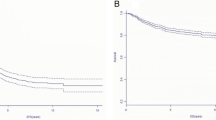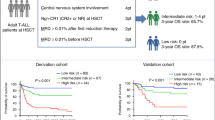Abstract
This study aimed to analyse the characteristics and treatment outcomes of adult patients with acute lymphoblastic leukaemia (ALL) and construct nomogram predictive models for prognosis prediction. Between January 2017 and June 2022, 462 adult patients with ALL were included in this retrospective analysis. Patients’ ages ranged from 14 to 84 years. B-cell origin was observed in 82.7% of these patients, while 17.3% of the cases were of T-cell origin. The BCR/ABL1 fusion gene was detected in 32.9% of those with B-ALL. Complete remission was achieved in 83.7% of the patients after induction chemotherapy. The median disease-free survival (DFS) and overall survival (OS) of patients were 19.0 and 39.1 months, respectively. The 5-year DFS and OS rates were 29.5% and 41.8%, respectively. The BCR/ABL1 fusion gene had a significant adverse impact on DFS and OS when patients were treated with tyrosine kinase inhibitors (TKIs) and chemotherapy; however, this effect was eliminated when patients underwent transplantation. Multivariate analysis identified that age ≥ 35 years, white blood cell count ≥ 30 × 109/L, platelet count < 100 × 109/L, failure to achieve complete remission after induction chemotherapy, positive measurable residual disease (MRD), and absence of transplantation were independent adverse prognostic factors for DFS and/or OS. Nomogram predictive models constructed by the rms package in R software based on these prognostic factors demonstrated precise predictive value. In conclusion, adult patients with ALL experience poor survival. TKIs in combination with transplantation can eliminate the adverse effects of BCR/ABL1 fusion genes on prognosis. Nomogram predictive models were accurate for prognostic prediction and will be useful in clinical practice.







Similar content being viewed by others
Data availability
The original data analysed during the current study are available from the corresponding author on reasonable request.
References
Siegel RL, Miller KD, Fuchs HE et al (2021) Cancer Stat 2021 CA Cancer J Clin 71:7–33
Jabbour EJ, Faderl S, Kantarjian HM (2005) Adult acute lymphoblastic leukemia. Mayo Clin Proc 80:1517–1527
Faderl S, O’Brien S, Pui CH et al (2010) Adult acute lymphoblastic leukemia: concepts and strategies. Cancer 116(5):1165–1176
Huguet F, Leguay T, Raffoux E et al (2009) Pediatric-inspired therapy in adults with Philadelphia chromosome-negative acute lymphoblastic leukemia: the GRAALL-2003 study. J Clin Oncol 27(6):911–918
Toft N, Birgens H, Abrahamsson J et al (2018) Results of NOPHO ALL2008 treatment for patients aged 1–45 years with acute lymphoblastic leukemia. Leukemia 32(3):606–615
Gokbuget N, Dombret H, Ribera JM et al (2016) International reference analysis of outcomes in adults with B-precursor Ph-negative relapsed/refractory acute lymphoblastic leukemia. Haematologica 101:1524–1533
Paul S, Rausch C, Nasnas P et al (2019) Treatment of relapsed/refractory acute lymphoblastic leukemia. Clin Adv Hematol Oncol 17:166–175
Rowe JM (2010) Prognostic factors in adult acute lymphoblastic leukaemia. Br J Haematol 150(4):389–405
Greil C, Engelhardt M, Ihorst G et al (2021) Prognostic factors for survival after allogeneic transplantation in acute lymphoblastic leukemia. Bone Marrow Transpl 56(4):841–852
Bleyer A (2021) Important factors improving outcome of young adults with acute lymphoblastic leukemia (ALL). Best Pract Res Clin Haematol 34(4):101322
Fedullo AL, Messina M, Elia L et al (2019) Prognostic implications of additional genomic lesions in adult Philadelphia chromosome-positive acute lymphoblastic leukemia. Haematologica 104(2):312–318
Ma R, Liu XT, Chang YJ (2022) Allogeneic hematopoietic stem cell transplantation for acute lymphoblastic leukemia: current status and future directions mainly focusing on a Chinese perspective. Expert Rev Hematol 15(9):789–803
DeFilipp Z, Advani AS, Bachanova V et al (2019) Hematopoietic cell transplantation in the treatment of adult Acute Lymphoblastic Leukemia: updated 2019 evidence-based review from the American Society for Transplantation and Cellular Therapy. Biol Blood Marrow Transpl 25(11):2113–2123
Speziali C, Paulson K, Seftel M (2016) Hematopoietic cell transplantation for Acute lymphoblastic leukemia in adults. Curr Hematol Malig Rep 11(3):175–184
Rita Alaggio C, Amador I, Anagnostopoulos et al (2022) The 5th edition of the World Health Organization Classification of Haematolymphoid Tumours: lymphoid neoplasms. Leukemia 36(7):1720–1748
Cui L, Li Z-G, Chai Y-H et al (2018) Outcome of children with newly diagnosed acute lymphoblastic leukemia treated with CCLG-ALL 2008: the first nation-wide prospective multicenter study in China. Am J Hematol 93(7):913–920
Hagop Kantarjian D, Thomas et al (2004) Susan O’Brien,. Long-term follow-up results of hyperfractionated cyclophosphamide, vincristine, doxorubicin, and dexamethasone (Hyper-CVAD), a dose-intensive regimen, in adult acute lymphocytic leukemia. Cancer. ;101(12):2788 – 801
Cheson BD, Bennett JM, Kopecky KJ et al (2003) Revised recommendations of the International Working Group for Diagnosis, standardization of response criteria, treatment outcomes, and reporting standards for therapeutic trials in Acute myeloid leukemia. J Clin Oncol 21:4642–4649
Paul S, Kantarjian H, Jabbour EJ et al (2016) Adult Acute Lymphoblastic Leukemia. Mayo Clin Proc. ;91(11):1645–1666
Gökbuget N, Hoelzer D (2009) Treatment of adult acute lymphoblastic leukemia. Semin Hematol 46(1):64–75
Huguet F, Chevret S, Leguay T et al (2018) Intensified therapy of Acute lymphoblastic leukemia in adults: report of the Randomized GRAALL-2005 clinical trial. J Clin Oncol 36(24):2514–2523
Pui CH, Campana D (2007) Age-related differences in leukemia biology and prognosis: the paradigm of MLL-AF4-positive acute lymphoblastic leukemia. Leukemia 21(4):593–594
Aldoss I, Forman SJ, Pullarkat V (2019) Acute lymphoblastic leukemia in the older adult. J Oncol Pract 15(2):67–75
Mrózek K, Harper DP, Aplan PD (2009) Cytogenetics and molecular genetics of acute lymphoblastic leukemia. Hematol Oncol Clin North Am 23(5):991–1010
Jacobson S, Tedder M, Eggert J (2016) Adult Acute Lymphoblastic Leukemia: a genetic overview and application to clinical practice. Clin J Oncol Nurs 20(6):E147–E154
Horowitz NA, Akasha D, Rowe JM (2018) Advances in the genetics of acute lymphoblastic leukemia in adults and the potential clinical implications. Expert Rev Hematol 11(10):781–791
Burmeister T, Schwartz S, Bartram CR, et al. Patients’ age and BCR-ABL frequency in adult B-precursor ALL: a retrospective analysis from the GMALL study group. Blood 2008;112(3):918–9
Foà R, Chiaretti S (2022) Philadelphia chromosome-positive Acute Lymphoblastic Leukemia. N Engl J Med 386(25):2399–2411
Jabbour E, Short NJ, Ravandi F et al (2018) Combination of hyper-CVAD with ponatinib as first-line therapy for patients with Philadelphia chromosome-positive acute lymphoblastic leukaemia: long-term follow-up of a single-centre, phase 2 study. Lancet Haematol 5(12):e618–e627
Jabbour E, Short NJ, Jain N et al (2023) The evolution of acute lymphoblastic leukemia research and therapy at MD Anderson over four decades. J Hematol Oncol 16(1):22
Park HS (2020) Current treatment strategies for Philadelphia chromosome-positive adult acute lymphoblastic leukemia. Blood Res 55(S1):S32–S36
Bourlon C, Lacayo-Leñero D et al (2018) Hematopoietic stem cell transplantation for adult Philadelphia-negative Acute Lymphoblastic Leukemia in the First Complete Remission in the era of minimal residual disease. Curr Oncol Rep 20(4):36
Khazal S, Kebriaei P et al (2021) Hematopoietic cell transplantation for acute lymphoblastic leukemia: review of current indications and outcomes. Leuk Lymphoma 62(12):2831–2844
Bartram J, Patel B, Fielding AK (2020) Monitoring MRD in ALL: methodologies, technical aspects and optimal time points for measurement. Semin Hematol 57(3):142–148
Acknowledgements
We greatly appreciate all patients with ALL who supported this study. We would like to thank Editage (www.editage.cn) for the English language editing.
Funding
This work was supported by Joint Funds for the innovation of science and Technology, Fujian province(2021Y9086), National Natural Science Foundation of China (U2005204,82000142), Natural Science Foundation of Fujian Province (2022J01264), Startup Fund for scientific research, Fujian Medical University (2021QH2021), and Startup Fund for scientific research, Fujian Medical University (2020QH1079).
Author information
Authors and Affiliations
Contributions
Yi Chen analyzed the data and wrote the main manuscript; Yanxin Chen, Zhengjun Wu, and Jiazheng Li analyzed the data and prepared the tables and figures; Yan Huang, Xiaomei Peng and Jing Zheng collected the material; Jianda Hu and Yong Wu designed this study and revised the manuscript. All authors reviewed the manuscript.
Corresponding authors
Ethics declarations
Ethical approval
(Approval of the research by an Institutional Reviewer Board: The clinical study was approved by the Institutional Reviewer Board of the Fujian Medical University Union Hospital (Ethical Approval Number: 2023KJCX090).)
Registry and the Registration No. Of the study/trial
Not applicable.
Animal studies
Not applicable.
Conflict of interest
All authors have read the journal’s policy on disclosure of potential conflict of interest and have none to declare.
Additional information
Publisher’s Note
Springer Nature remains neutral with regard to jurisdictional claims in published maps and institutional affiliations.
Electronic supplementary material
Below is the link to the electronic supplementary material.




Rights and permissions
Springer Nature or its licensor (e.g. a society or other partner) holds exclusive rights to this article under a publishing agreement with the author(s) or other rightsholder(s); author self-archiving of the accepted manuscript version of this article is solely governed by the terms of such publishing agreement and applicable law.
About this article
Cite this article
Chen, Y., Chen, Y., Wu, Z. et al. Nomogram predictive models for adult patients with acute lymphoblastic leukaemia based on real-world treatment outcomes. Ann Hematol (2024). https://doi.org/10.1007/s00277-024-05692-1
Received:
Accepted:
Published:
DOI: https://doi.org/10.1007/s00277-024-05692-1




